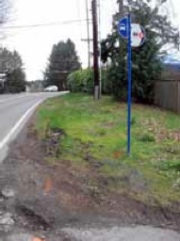
Executive Director Stephanie Routh
speaking at a 2009 event.
(Photo © J. Maus)
On the heels of recent media attention on the need for safer streets and news of an 80% increase in walking-involved fatalities and injury crashes in Oregon this year, the non-profit Willamette Pedestrian Coalition (WPC) unveiled their Getting Around on Foot Action Plan at a press conference in Beaverton today.
The plan presents an overview of challenges our transportation planners face in creating a more walkable (and rollable, in the case of wheelchair and other mobility device users) region. From the Executive Summary (which you can read in its entirety below):

(Photo: WPC)
“The Action Plan is designed to encourage decision-makers who draft policies and direct investments to design a comprehensive pedestrian network as their priority and to fund its development. We hope community members can and will use this Action Plan as a resource to advocate for more walkable/rollable neighborhoods.”
The WPC gleaned their information from the report based on conversations with transportation planners from 19 of the 24 various jurisdictions around the Portland metro area, citizen surveys, and field observations. From that work, three themes emerged: the need for safer crossings, more walkable destinations, and a greater focus on making sure our system meets the mobility and access needs of an aging population.
A lack of funding for walking-specific infrastructure was cited as one of the top 12 “Key Findings” in the report. On the lack of funding, the report states:
“This is not, fundamentally, an issue of money; it is an issue of political will. One hundred percent of our region’s population use sidewalks and crossings daily, yet generally less than one percent of transportation budgets are available to improve walking conditions…
Pedestrian infrastructure needs its own dedicated funding sources that are not exclusively reliant on development- related improvements… Funding sources should be as stable and diverse as the funding identified for automobile transportation. Developing funding mechanisms for improving walking/rolling will require creativity, innovation, and political will.”
Slated to speak at today’s press event were: WPC Executive Director Stephanie Routh; Ian Jaquiss, Trailblazers Director of Community Programs; Jonathan Nicholas, Metro Executive Council for Active Transportation Chair; Neil McFarlane, TriMet General Manager; and Andrew Singelakis Washington County Land Use and Transportation Director.
This plan should help spur the already nascent local walking movement. Read the full plan and learn more about the Willamette Pedestrian Coalition at WPCWalks.org.
Browse the executive summary of the report below:
Getting Around on Foot Action Plan

